Hacienda tokens from Yucatán (Olegario Molina)
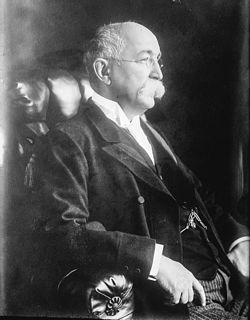 Olegario Molina Solis was born in Bolonchenticul, in present-day Campeche, in 1843, the son of a small farmer and businessman. He moved with his family to Yucatán's capital, Mérida, in 1857, after the Caste War of Yucatán ravaged his family's properties. After securing degrees in law and topographical engineering, Molina served as secretary to Liberal General Manuel Cepeda Peraza, who defeated Emperor Maximilian's forces in the peninsula in 1867. During the 1870s Molina became an engineer, superintendent, and later a partner in the first railroad built in Yucatán, the Mérida—Progreso railway, which he helped complete, became the owner of six henequen plantations, and one of the wealthiest families in the state. In 1881 he founded the casa comercial O. Molina y Cía. with his son-in-law Avelino Montes, to export henequén. It is believed that Molina and Montes worked to depress fibre prices to benefit their North American partners, the International Harvester Company (and themselves). They used their dominant position in the fibre trade to expand the investment base of their company dramatically. Ventures in real estate, import/exports, and speculation in local industry, commerce, and infrastructure made Molina and Montes, and their extended network of family and friends, an economic octopus in turn-of-the-century Yucatán.
Olegario Molina Solis was born in Bolonchenticul, in present-day Campeche, in 1843, the son of a small farmer and businessman. He moved with his family to Yucatán's capital, Mérida, in 1857, after the Caste War of Yucatán ravaged his family's properties. After securing degrees in law and topographical engineering, Molina served as secretary to Liberal General Manuel Cepeda Peraza, who defeated Emperor Maximilian's forces in the peninsula in 1867. During the 1870s Molina became an engineer, superintendent, and later a partner in the first railroad built in Yucatán, the Mérida—Progreso railway, which he helped complete, became the owner of six henequen plantations, and one of the wealthiest families in the state. In 1881 he founded the casa comercial O. Molina y Cía. with his son-in-law Avelino Montes, to export henequén. It is believed that Molina and Montes worked to depress fibre prices to benefit their North American partners, the International Harvester Company (and themselves). They used their dominant position in the fibre trade to expand the investment base of their company dramatically. Ventures in real estate, import/exports, and speculation in local industry, commerce, and infrastructure made Molina and Montes, and their extended network of family and friends, an economic octopus in turn-of-the-century Yucatán.
After 1902 Molina not only was the most powerful economic force in the region (as a result of the Harvester contract), but also exercised considerable political authority. In 1903, Governor Molina began to amass a landed empire in Yucatán. At a state-run auction of the possessions of a wealthy hacendado who had just died, Molina bought Haciendas Chochóh and Cacao in Tixkokob partidoYucatán during the Porfiriato was divided into sixteen political districts called partidos for the extremely low price of 150,000 pesos, precisely at a time when boom prices had inflated property values. Included in the transaction were Haciendas Monchac and Kilinché and several adjoining tracts (anexos) for 75,000 pesos each. Although a lack of data prevents a direct connection between Molina’s political position and the acquisition of the haciendas, the fact remains that Molina was able to purchase all of León Ayala’s profitable estates at a fraction of their “real” value.
After purchasing the aforementioned estates, Olegario later bought haciendas in the Tixkokob, Mérida, and Izamál partidos. In addition, he purchased large tracts of land in Espita, 150 kilometres east of Mérida, a fertile sugar-growing region. By 1912, Molina was one of the largest sugar producers in the state; his San Francisco Holcá mill processed 18,400 kilograms of sugar and 46,000 kilograms of molasses and honey a year. By the end of the Porfiriato, Molina not only was the single largest landowner in the state, but his haciendas cultivated more henequen than those of any other planter.
At the end of 1907 Molina deployed all his forces to destroy the group headed by the Escalentes and gain total control of henequén production and the Ferrocarriles Unidos driving the Escalente companies into bankruptcy and accusing them of fraud.
Molina was a federal deputy from 1869 to 1871 and 1873 to 1875, senator from Oaxaca for 1900 and 1902, and governor of Yucatán for two terms, from 1 February 1902 to 6 March 1907. As governor he is remembered for the number of schools he built, the paving and draining of Mérida's streets, and a spate of capital improvement projects in Mérida (O. Molina y Compañía received lucrative contracts for many of these capital projects.) He also reorganized the property registry, rewrote the state constitution, reformed the penal and civil codes, and reorganized the state National Guard and Mérida police force.
In 1906 President Porfirio Díaz visited Mérida, and after marveling at all of the impressive physical changes, rewarded Molina by making him, in Match 1907, his Secretario de Fomento, Colonización e Industria. He fled to Havana in 1911 and died in exile on 28 April 1925.
Sacnicté
Sac Nicté is located in the municipio of Bolón (now Umán) in the department of Hunucmá.
Olegario and Trinidad Molina's mongram appears on these tokens
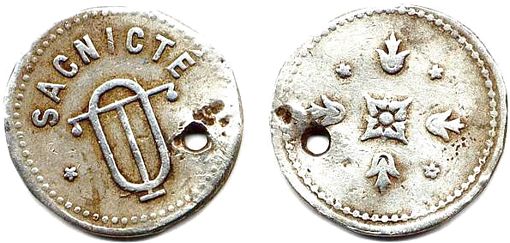
Grove 1857
Obverse: above a monogram OT SACNICTE
Reverse: ornate design
22mm. nickel
Grove 1858
Obverse: above a monogram OT SACNICTE
Reverse: ornate design, counterstamped L. C. / 20
22mm. nickel
Grove 1859
Obverse: above a monogram OT SACNICTE
Reverse: ornate design
25mm. nickel
There are two tokens asigned to the earlier owner of the hacienda. Silverio Sansores.
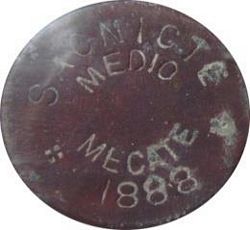
Obverse: SACNICTE / MEDIO / MECATE / 1888
Reverse: blank
27mm.
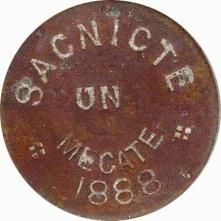
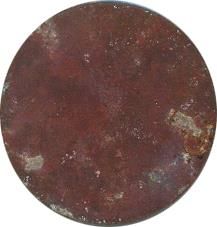
Obverse: SACNICTE / UN / MECATE / 1888
Reverse: blank
28mm.
Sanlahtah
Sanlahtah is located in the municipio of Tekantó, about 60 kilometres east of Mérida.
Olegario and Trinidad Molina's mongram appears on these tokens
Grove 1870
Obverse: above a monogram SANLAHTAH
Reverse: an ornate design
21 mm. nickel
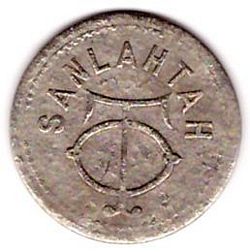
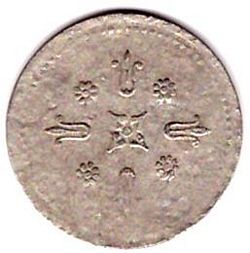
Grove 1871
Obverse: above a monogram SANLAHTAH
Reverse: an ornate design
25 mm. nickel
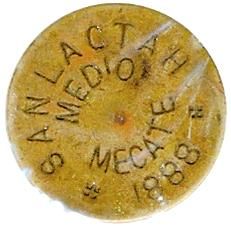
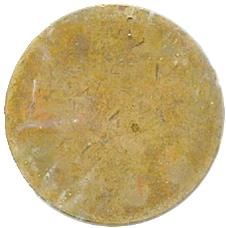
Obverse: SANLAHTAH / MEDIO / MECATE / 1888
Reverse: blank
27 mm.
Obverse: above a monogram SANLAHTAH
Reverse: an ornate design
27.5 mm.
Also
